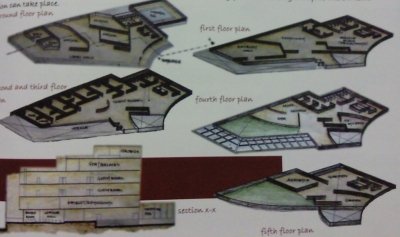School of Planning and Architecture – SPA – Delhi
Concept
There are codes and with are de-codes. Environment by itself has a series of relationship with its elements with a certain pattern and alike to it is the city of Delhi. It holds within it layers of architecture of different time periods and eventually today it stands as a example of a place which has held all threads together yet attaining the cosmopolitan balance required to day. The design tries and depicts the essence of the spaces in Delhi like the gallis, chowks, dhabas…etc. by coming out with spaces which code and un-code visually or as per the activity pattern. The design further developed by understanding what a convention centre means in the Indian context hence consciously efforts have been on the lines to come out with a design which drifts away from the mall culture of Delhi and to come out with an amalgamation of ethnic elements of the capital city with the new age technology.
Site Justification and Analysis
Location:
Lodhi road, New Delhi
The road in front being 25m wide. The area is surrounded by many historical and official buildings like the Humayun’s Tomb and the Indian Habitat Centre respectively for making the site desirable for the project. Also the fact that the chosen area has green spaces along with public transport facilities add to the viability factor of choosing the mentioned site for the design.
Design
The form tries to create visual impact to catch the attention of the moving traffic by playing with the height of the built structure depending on the function.
The entrance has been buffered with green spaces trying to match the visual context offered by the space around the Lodhi road. The site notices fragmentation of the spaces into blocks keeping in mind the coding and de-coding of spaces. This also facilitates the easy flow of wind plus providing more surface exposed to sunlight.
Convention block
This block is located near the entrance. It has windows facing the lobby which have been consciously placed so that the interiors of the space experience diffused lighting by the use of Jaalis which has been an important element in historic buildings which are located in Delhi.

The three-stories building has an atrium which overlooks the lobby giving it a well lit environment. The balconies which are provided in the floor for guest, has not been treated as an individual entity but as a part of the huge cut-out with seating facilities making it a space where interaction can take place.
Library and Exhibition Block
The library and exhibition spaces have been designed as a part of a single block. The study area is on the third floor where in North light fixed windows are provided as roof hence allowing diffused light.
The south facing spaces have windows with slits which reduces the glare brought in the exhibition spaces facing that direction simultaneously creating a dramatic play of light. Internally the exhibition space has flexibe cubicles in Euro bond. Care has also been taken to provide workshop spaces for people using the exhibition.
Administration Block and Restaurant
The form of this block is such that it provides relativity with the road in order to maintain the visual connectivity. The space has been provided with the reflection of dhabas with only roof and charpais hence breaking the monotony of modern restaurants.
Auditorium Block
This block required spill over spaces to dilute the heavy crowd and additional to that the entire space opens up to a water body creating a pleasing effect. Above the acoustically sound form, the OAT has been designed. This open area with the isolated arched openings at its end give the barren monumental touch which is again a part of the capital city.
Design Efficiency Methods
Water Utilization
Storm water purification unit has been designed to enable the water to be used or fire fighting, AC refrigerant and facility requirements. Use of low flush toilets, use of auto flush urinal control.
Material Sourcing
Making use of cellular material for blinds and curtains, use of low VOC paints, use of recycle concrete for pavements and pathways. It helps in improving energy efficiency and making it a green project.
Lighting
Use of Y-8 compact fluroscent lamps, use of photo-sensitive dimmers, to massively reduce energy consumption and make it more sustainable in the long run.



i love this plan , can i get them in details.
I don’t have detailed plans of that institution.
The site view for the SPA project certainly caught my eye. It’s very imaginative.
tank you very much. i am irainian
thanks fr d info….
hey..this is very intresting…i would like to see pictures of the hostel blocks of spa delhi if that is possible as a part of my research for my thesis
nice….Kindly update more things which are valuable for xasstudy of spa for thesis